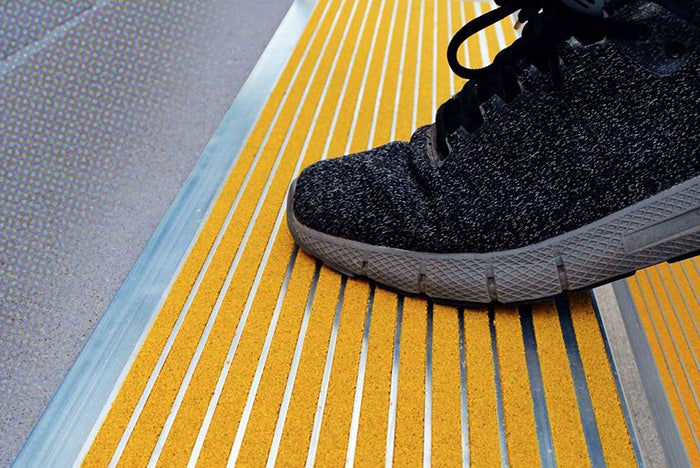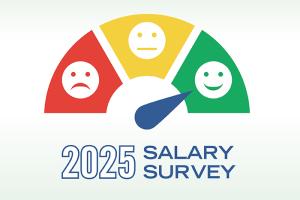Protect people on hospital staircases

Image courtsey of Amstep
It’s estimated that more than one million people are treated annually in hospital emergency rooms due to stair-related injuries. But we rarely consider stair safety within the hospitals in which such injuries are being treated.
In 2020, according to the Bureau of Labor Statistics, more than 28,000 health care workers were injured badly enough to miss at least one workday.1 In addition, according to The Hartford, slips, trips and falls make up 66% of all claims and 44% of lost costs in the U.S. health care sector.2
Hospital stair safety can fall into a grey area of responsibility. Some facilities might task this major responsibility to the facilities staff or the maintenance crew, but are these people properly trained to evaluate stairs for safety conditions, and bring attention to stair issues before an adverse event happens?
Given all the pressing areas within a hospital that compete daily for attention and resources, it's easy to understand how stair safety can be overlooked. However, in weighing the benefits of proactive safety measures against the high cost of negligence, maintaining safe and slip-resistant stairs becomes a high priority.
Who uses hospital stairs
When evaluating who uses the stairs most frequently in a hospital, it is usually the employees or visitors who are in a rush and don’t want to wait for the elevator. Maybe it’s a nurse running late to care for a patient, or a soon-to-be dad trying to get to the maternity ward for the arrival of his first child.
Safety and health professionals agree that rushing is a state of mind that leads to critical errors. People aren’t just moving fast when they are rushing, they can also be distracted. Regardless of the reason, rushing up or down hospital stairs can increase the chance of a slip or fall.
Logic would dictate that most stair travel in a hospital would be going downstairs. Patients and employees are unlikely to climb stairs over multiple floors. Climbing downstairs is less rigorous and can be faster than waiting for elevators if traveling for only a few floors. Unfortunately, going downstairs creates a greater problem as it is likely to lead to more severe injuries in the event of a trip or fall. People tripping downstairs will likely fall a greater distance and tumble downstairs until they reach a landing.
Stair usage in emergency situations
Other situations that require people to take the hospital stairs are power outages or emergency evacuations. Again, these are scenarios where people might be frantic or rushing and the stairs crowded. A slip-and-fall accident during an emergency could be detrimental to the individual and the others attempting to exit the hospital.
Administrators and safety leaders never know when these emergency situations will occur, so it’s imperative to maintain safe and slip-resistant stairs for employees and visitors.
Actively assess stair safety
The best time to assess stair safety is before an accident or emergency occurs and an employee or visitor is seriously injured. Evaluate stairs routinely to access maintenance and safety issues.
Carefully monitor:
- Contamination by water leaks or foreign substances.
- Lighting issues to ensure stairs are well visible.
- Handrails for wiggle or signs of wear.
- Stair nosing for rounding or worn and slippery slopes.
- Vinyl or rubber treads for deterioration.
- Coefficient of friction (COF) to confirm proper traction.
Safe walking surfaces have a high COF, which measures the resistance between two surfaces, such as someone’s shoe and the floor they’re walking on.
COF is measured on a scale from 0 to 1, with 1 being excellent for slip and fall safety. The Occupational Safety and Health Administration (OSHA) recommends a COF of 0.5 or higher, although that is on the low side of the range for safe performance. Ensure the COF remains high even when the stair surface is wet. A product that fails when wet does nothing to improve safety. Materials or surfaces that maintain high COF, wet or dry, will provide the most traction in any situation.
If the hospital staff lacks trained experts, consider bringing in a certified Walking-Working Surfaces and Fall Protection Specialist to conduct a safety inspection with a well-trained eye. These third-party experts often conduct complimentary audits and can recommend safety improvements that are durable and sustainable to help align with the hospital’s broader goals.
Make smart selections
If an audit determines any part of the staircase is unsafe, don’t put a band-aid on something that needs a splint. Fix the problem with a durable, long-term solution that provides lasting safety.
Stair nosings and treads are value-added components commonly used on stairways and other walking surfaces. A step with a stair nosing installed will wear more slowly than a naked step. Since the nose of a stair gets more impact and contact than any other part of the step, it will wear more quickly than the rest of the step. The stair nosing is designed to stand up to more impact than the bare stair tread without cracking, wearing or breaking. Stairs will last longer with quality nose protection than without them. Anti-slip stair nosings can be added when building new steps or when renovating existing steps.
Stair treads are another important aspect of stair safety. A good indoor stair tread can increase the grip that a person has on each step, helping to prevent slip-and-fall injuries.
Hospitals have unique needs for safe surface materials. Not only do the stairs need to have slip-resistant high traction, but they also need to be hygienic. Nonporous applications are critical due to the numerous pathogens that come through these facilities.
Hospitals should consider stair materials that:
- Meet COF standards for high traction.
- Will not absorb dirt, liquids or common contaminants.
- Are easily cleaned with routine cleaning procedures.
- Maintain slip-resistant properties when wet or dry.
- Have long-lasting durability to minimize the frequency of repairs and replacement costs.
Plan for individuals with visual impairments
Some areas, such as California, have mandated stair regulations to improve safety for those who are visually impaired. These mandates require all stair nosing be equipped with a visual contrast color to differentiate between the step and the tread. Whether you are in a mandated area or not, adding contrasting high-visibility sightlines is an added safety precaution that benefits everyone.
Be well prepared for the emergency scenario. In these situations, stairs can pose a significant safety hazard. While stairwells in buildings are normally well lit, unforeseen circumstances such as power outages or fires can interrupt an electrical system and plunge a staircase into darkness. For those using the stairs, the possibility of missing a step or tripping and falling is a very real threat and has the potential to cause significant injury.
Consider nonslip stair treads and nosings with glow-in-the-dark material like photoluminescent technology to ensure stairs remain visible in an emergency and minimize the risks associated with people rushing down a dark set of stairs.
Compare cost of prevention versus cost of inaction
While it may seem difficult to find the resources to make stair safety improvements, neglecting a worn or slippery staircase can be even more expensive. According to the 2023 Liberty Mutual Workplace Safety Index, U.S. businesses spent about $15 billion in 2020 on direct costs from slip and fall worker injuries.3
Ultimately, health care facilities have an obligation to look after their patients, employees and visitors. Proactive stair maintenance and safety comes with some expense, but the cost savings can be enormous. When stairs are fit with high-traction safety solutions — visible in the dark and dependable when contaminated or wet — hospital administrators, maintenance managers and safety champions can rest easier knowing they took proactive steps for long-lasting stair safety.
For more technical information on stair regulations and safety materials for stair renovations, visit Amstep.com.
References
1U.S. Bureau of Labor Statistics. (2021, November 3). Table R12. number of nonfatal occupational injuries and illnesses involving days away from work by occupation and selected events or exposures leading to injury or illness, private industry, 2020. U.S. Bureau of Labor Statistics. Retrieved October 9, 2023, from https://www.bls.gov/iif/oshwc/osh/case/cd_r12_2020.htm.
2The Hartford. (n.d.). Slip, trip and fall prevention for healthcare workers. Slip, Trip and Fall
Prevention for Health Care Workers. Retrieved October 9, 2023, from https://www.thehartford.com/insights/home-workplace-safety/slips-trips-falls-in-healthcare.
32023 workplace safety index: The top 10 causes of disabling injuries. Liberty Mutual Business Insurance. (2021, July 15). Retrieved October 9, 2023, from https://business.libertymutual.com/insights/2023-workplace-safety-index/
Patrick Sullivan is product director at Amstep.




